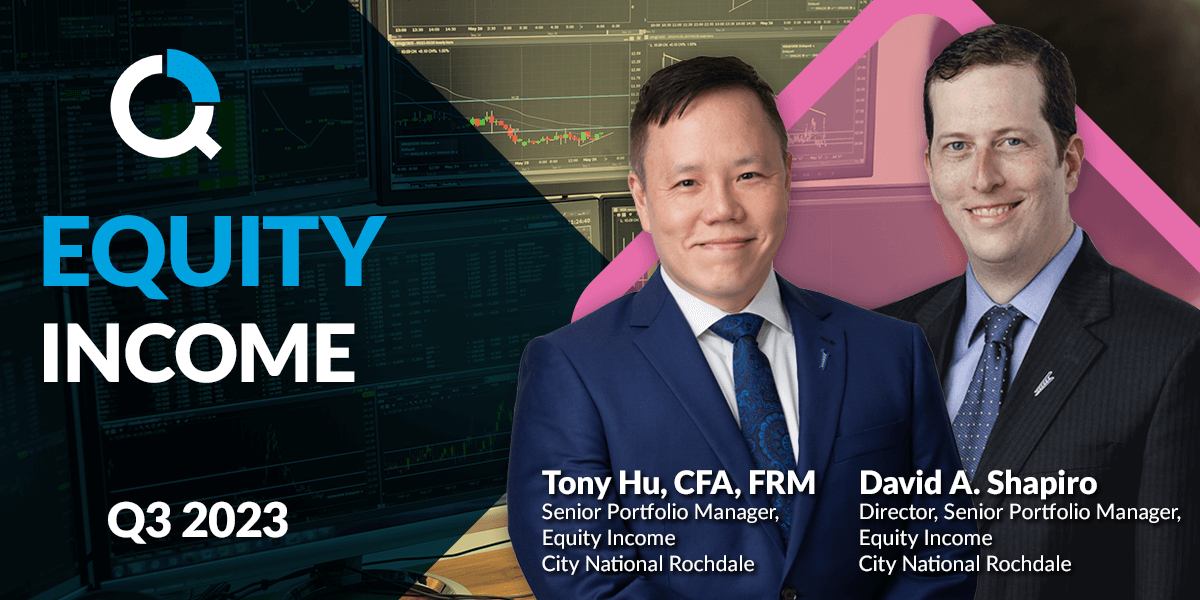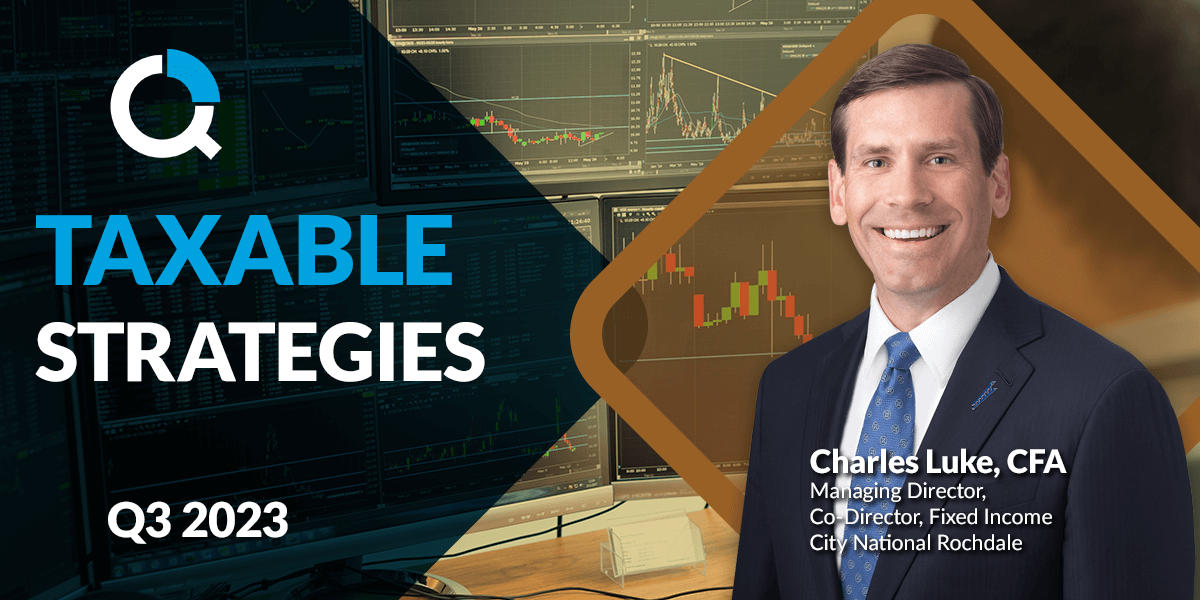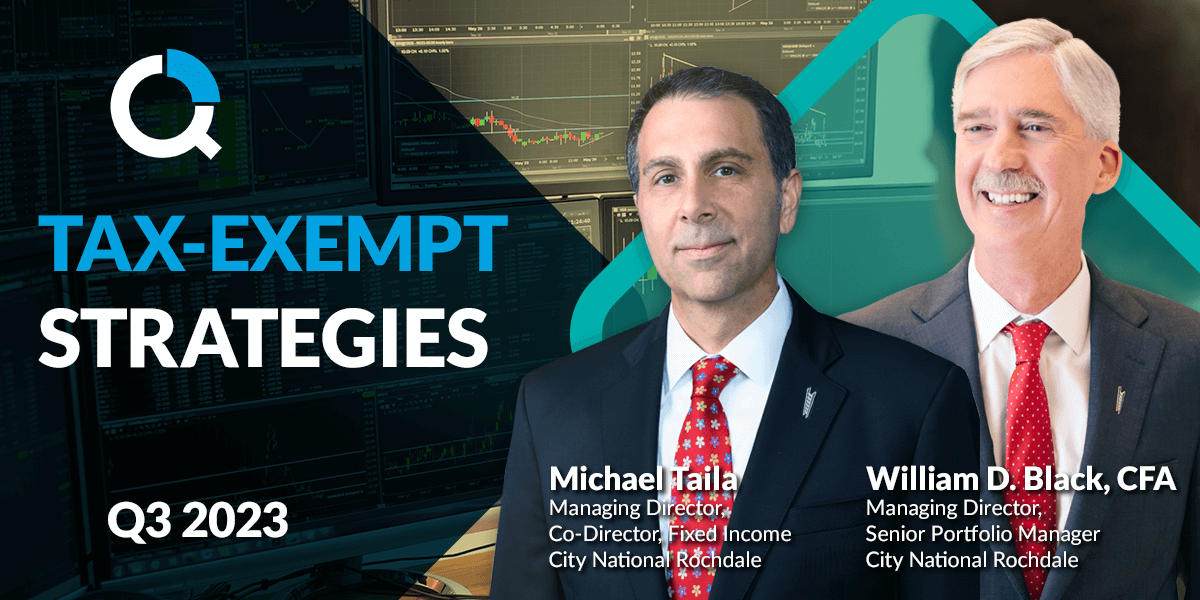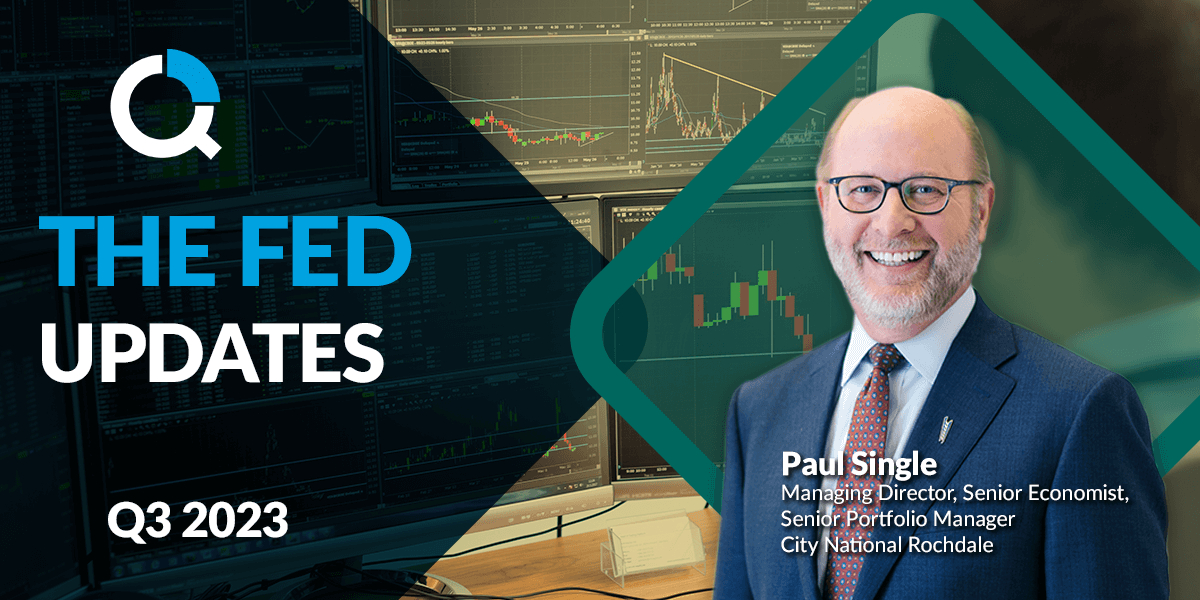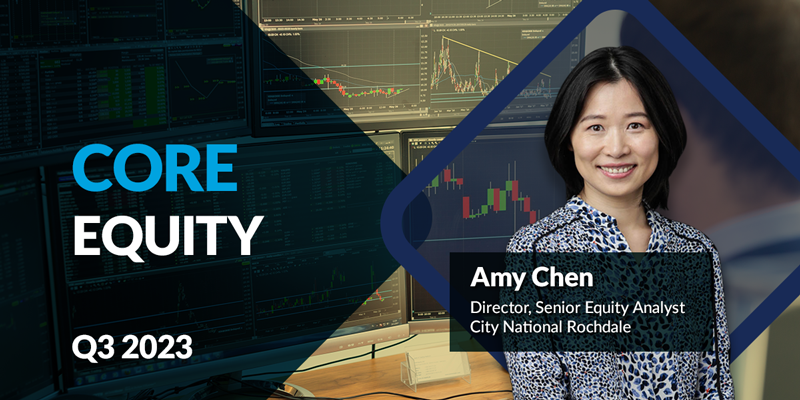
Market Update: Investing in Uncertain Times
Key Points
- CNR maintaining modest defensive positioning.
- Normal recession now likely to be avoided, but still expect mild recessionary period in early 2024.
- Equity prospects becoming more attractive, but too early to give the all-clear signal.
- Continue to see better risk-reward opportunities in fixed income.
Despite a U.S. economy that continues to shine with unexpected resilience, financial markets have found themselves under increasing pressure as we head toward year end.
From surging bond yields to government shutdown fears to geopolitical concerns, there’s been plenty for investors to worry about — but there’s also reason for optimism. We suspect markets may remain volatile in the near term, prompted by temporary uncertainties as well as more structural challenges like the impact of higher interest rates on the economy and corporate profits. But for long-term investors, the decline in stock and bond prices is creating more attractive buying opportunities if one is patient.
In recent months, stocks have largely taken their cues from the bond market, as the Fed’s message of a higher-for-longer interest rate environment seems to have finally been absorbed by markets. The rapid move higher in government bond yields has increased volatility in both equities and bonds. Higher yields can increase the cost of borrowing, weigh on bond price returns and put downward pressure on stock valuations. Notably, mega-cap technology stocks, which have driven the lion’s share of equity gains since last October’s low and often trade at a premium due to their growth prospects, find themselves particularly exposed.
Although it’s been disappointing to not capture more of the upside concentrated portion of U.S. stock markets this year, with major U.S. equity indices now near correction territory, we believe that our mild defensive positioning is proving prudent. Near-term challenges should keep volatility elevated and perhaps vulnerable to additional pullbacks. We don’t think that the impact of the prior Fed rate hikes has been completely felt by the economy. Higher borrowing costs are soon likely to show a more noticeable impact on the consumer spending and business investment. While a still-strong labor market and solid household finances will help mitigate a slowdown ahead, a short and mild recession will be hard to avoid in coming quarters, as will disappointments in corporate earnings.
Still, an approaching end to the Fed’s rate hiking cycle now suggests that a more normal recession will be avoided and has given us reason to begin peeking over walls of worry.
Chart 1: Recession Probability
Sources: Bloomberg, CNR Research, Blue Chip Economic Forecasts as of September 2023. Information is subject to change and is not a guarantee of future results.
Yields might overshoot in the near term, and rise above 5%, particularly given the outsized supply of Treasuries coming to market. But as economic growth decelerates, inflation moderates and the Federal Reserve steps to the sidelines, interested rates are expected to peak and over time gradually moderate, reducing pressure on equity valuations.
While on the surface valuations are still not cheap relative to current bond yields, with the recent pullback in stock prices many segments of the equity market are already now trading at what we believe are more compelling levels. This is allowing us to start looking over an expected mild recessionary valley ahead to a recovery of corporate profit growth in the second half of 2024. In fixed income, the recent sell-off in bonds is also creating a buying opportunity. Three years of negative bond returns would be unprecedented, but the upside of this historic decline is that with yields now at very attractive levels, the larger income component can better offset price decreases to produce overall higher total returns going forward.
As uncertainties subside, we believe that we have a disciplined game plan in place to take advantage of these opportunities and increase equity exposure. For now though, it appears premature to give the all-clear sign. Given the risks of a short and shallow recession, falling corporate earnings, and a correction of a narrow and expensive stock market, we continue to think our mildly defensive portfolio positioning is a smart way to stay fully invested until clearer signs of the economy’s direction develop. Our fundamentally driven investment process has navigated several market cycles over the last 30 years, and today it is calling for continued patience, while our focus on holding high-quality and income-producing U.S. stocks and bonds can help provide client portfolios with relative stability as the investment environment grows more challenging.
Chart 2: S&P 500 EPS Growth 2024 Estimates
Sources: FactSet, CNR Research, as of October 6, 2023
Indices are unmanaged, and one cannot invest directly in an index. Information is subject to change and is not a guarantee of future results.
Important Information
The views expressed represent the opinions of City National Rochdale, LLC (CNR) which are subject to change and are not intended as a forecast or guarantee of future results. Stated information is provided for informational purposes only, and should not be perceived as personalized investment, financial, legal or tax advice or a recommendation for any security. It is derived from proprietary and non-proprietary sources which have not been independently verified for accuracy or completeness. While CNR believes the information to be accurate and reliable, we do not claim or have responsibility for its completeness, accuracy, or reliability. Statements of future expectations,estimates, projections, and other forward-looking statements are based on available information and management’s view as of the time of these statements. Accordingly, such statements are inherently speculative as they are based on assumptions which may involve known and unknown risks and uncertainties. Actual results, performance or events may differ materially from those expressed or implied in such statements.
All investing is subject to risk, including the possible loss of the money you invest. As with any investment strategy, there is no guarantee that investment objectives will be met, and investors may lose money. Diversification may not protect against market risk or loss. Past performance is no guarantee of future performance.
There are inherent risks with equity investing. These risks include, but are not limited to stock market, manager, or investment style. Stock markets tend to move in cycles, with periods of rising prices and periods of falling prices.
There are inherent risks with fixed income investing. These risks may include interest rate, call, credit, market, inflation, government policy, liquidity, or junkbond. When interest rates rise, bond prices fall.
Bloomberg risk is the weighted average risk of total volatilities for all portfolio holdings. Total Volatility per holding in Bloomberg is ex-ante (predicted) volatility that is based on the Bloomberg factor model.
Index Definitions
S&P 500 Index: The S&P 500 Index, or Standard & Poor’s 500 Index, is a market-capitalization-weighted index of 500 leading publicly traded companies in the US It is not an exact list of the top 500 US companies by market cap because there are other criteria that the index includes.
Bloomberg Barclays US Aggregate Bond Index (LBUSTRUU): The Bloomberg Aggregate Bond Index or “the Agg” is a broad-based fixed-income index used by bond traders and the managers of mutual funds and exchange-traded funds (ETFs) as a benchmark to measure their relative performance.
GT10: US Government Treasury Yield
Bloomberg Municipal Bond Index: The Bloomberg US Municipal Bond Index measures the performance of investment grade, US dollar-denominated, long-term tax-exempt bonds.
Bloomberg Municipal High Yield Bond Index: The Bloomberg Municipal High Yield Bond Index measures the performance of non-investment grade, US dollar-denominated, and non-rated, tax-exempt bonds.
S&P Leveraged Loan Indexes (S&P LL indexes) are capitalization-weighted syndicated loan indexes based upon market weightings, spreads and interest payments. The S&P/LSTA Leveraged Loan 100 Index (LL100) dates back to 2002 and is a daily tradable index for the US market that seeks to mirror the market-weighted performance of the largest institutional leveraged loans, as determined by criteria. Its ticker on Bloomberg is SPBDLLB.
Bloomberg US Corporate Bond Index: The Bloomberg Barclays US Corporate Bond Index measures the investment grade, fixed-rate, taxable corporate bond market. It includes USD-denominated securities publicly issued by US and non-US industrial, utility and financial issuers.
Bloomberg US High Yield Index: The Bloomberg US Corporate High Yield Index measures the performance of non-investment grade, US dollar-denominated, fixed-rate, taxable corporate bonds.
Bloomberg: LF98TRUU Index: The Bloomberg US Corporate High Yield Bond Index measures the USD-denominated, high yield, fixed-rate corporate bond market. Securities are classified as high yield if the middle rating of Moody’s, Fitch and S&P is Ba1/BB+/BB+ or below. Bonds from issuers with an emerging markets country of risk, based on Bloomberg EM country definition, are excluded. This is the total return index level.
Morningstar SPBDLLY Index: Yield to maturity time series of the Morningstar LSTA US Leveraged Loan 100 Index. The Morningstar LSTA US Leveraged Loan Index is a market-value weighted index designed to measure the performance of the US leveraged loan market.
Bloomberg Investment Grade Index: The Bloomberg US Investment Grade Corporate Bond Index measures the performance of investment grade, corporate, fixed-rate bonds with maturities of one year or more.
Bloomberg Municipal Bond Index: measures the performance of investment grade, US dollar denominated, long term tax exempt bonds. Bloomberg US Treasury Index: includes all publicly issued, U.S. Treasury securities that are rated investment grade, and have $250 million or more of outstanding face value.
Investment Grade (IG) Municipal Bond Index: The Bloomberg US Municipal Bond Index measures the performance of investment grade, US dollar-denominated, long-term tax-exempt bonds.
High Yield (HY) Municipal Bond Index: The Bloomberg Municipal High Yield Bond Index measures the performance of non-investment grade, US dollar-denominated, and non-rated, tax-exempt bonds.
Definitions
Yield to Worst (YTW) is the lower of the yield to maturity or the yield to call. It is essentially the lowest potential rate of return for a bond, excluding delinquency or default.
P/E Ratio: The price-to-earnings ratio (P/E ratio) is the ratio for valuing a company that measures its current share price relative to its earnings per share (EPS).
City National Rochdale Proprietary Quality Ranking formula: 40% Dupont Quality (return on equity adjusted by debt levels), 15% Earnings Stability (volatility of earnings), 15% Revenue Stability (volatility of revenue), 15% Cash Earnings Quality (cash flow vs. net income of company) 15% Balance Sheet Quality (fundamental strength of balance sheet).
*Source: City National Rochdale proprietary ranking system utilizing MSCI and FactSet data. **Rank is a percentile ranking approach whereby 100 is the highest possible score and 1 is the lowest. The City National Rochdale Core compares the weighted average holdings of the strategy to the companies in the S&P 500 on a sector basis. As of September 30, 2022. City National Rochdale proprietary ranking system utilizing MSCI and FactSet data.
Non-deposit investment Products are: • not FDIC insured • not Bank guaranteed • may lose value
Stay Informed.
Get our Insights delivered straight to your inbox.
Read more of this month's Quarterly Update below:
Put our insights to work for you.
If you have a client with more than $1 million in investable assets and want to find out about the benefits of our intelligently personalized portfolio management, speak with an investment consultant near you today.
If you’re a high-net-worth client who's interested in adding an experienced investment manager to your financial team, learn more about working with us here.
